Table of Contents
How to Avoid Endocrine Disruptors: 6 Practical Ways
This page may contain affiliate links. We may earn a commission on purchases, at no additional cost to you. Learn more →
Have you ever wondered how many hidden chemicals you're exposing yourself to? I certainly didn't - until persistent hormonal issues led me down a rabbit hole of research about endocrine disruptors. These sneaky chemicals lurk in everything, they're in our food and water, our everyday consumer products, even in the air we breathe, silently interfering with our body's natural hormone functions.
The reality is disturbing: research shows that endocrine disruptors can contribute to fertility problems, mood swings, weight issues, and even certain cancers.
When I first started learning about endocrine disrupting chemicals, I was overwhelmed, realising there was so many chemicals hiding in so many of the products I used everyday especially my beauty products. But here's the empowering part: we can take control. Through my own healing journey, I've discovered six simple yet powerful ways to reduce exposure to these chemicals. These aren't about making drastic overnight changes, by making gradual mindful changes to non-toxic products, you can significantly reduce your exposure.
Let me show you how to create a safer, healthier environment for yourself and your family. Here are six practical and manageable ways to reduce your exposure to endocrine disruptors today.
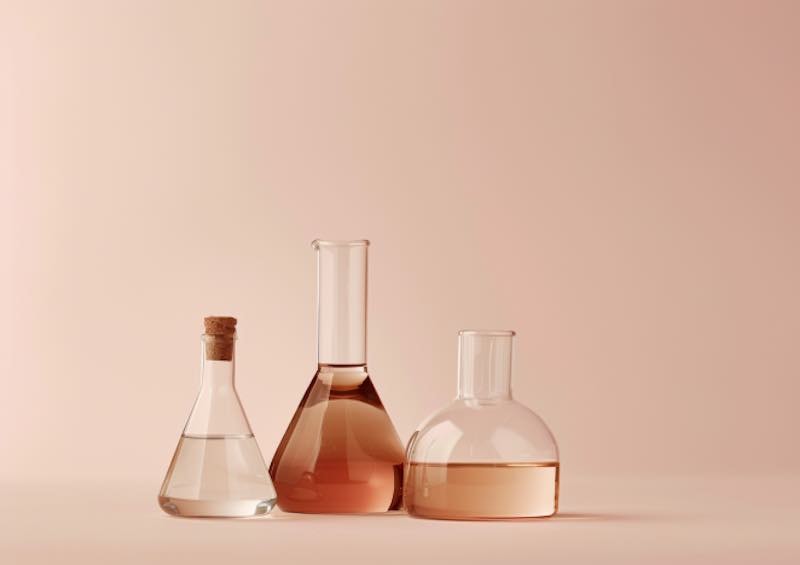
Understanding Endocrine Disruptors
Think of your endocrine system as your body's incredibly sophisticated messaging network. Scattered throughout your body are special glands, each producing unique hormones that act like chemical messengers in your bloodstream. These hormones orchestrate everything from your morning energy levels to your reproductive health, from your metabolism to your mood.
What are endocrine disruptors?
But here's where things get concerning: endocrine disruptors are like uninvited guests that crash this delicate messaging system.
Endocrine disruptors are natural or man-made chemicals found in many of our everyday products that can block, mimic or interfere with hormones produced by the endocrine system, that can cause a wealth of health problems. Alarmingly, out of the 85,000 man-made chemicals identified, it was reported that more than 1,000 could be endocrine disruptors.
Endocrine disruptors also drive chronic inflammation, a key factor in thyroid disorders like Hashimoto’s. Dr. Mark Hyman, a leading figure in the field of functional medicine explains: “Increased exposure to environmental toxins, chronic stress, and a poor diet are driving the epidemic of thyroid issues.” Endocrine disruptors like BPA, phthalates, and dioxins mimic or block hormones, wreaking havoc on this essential gland.
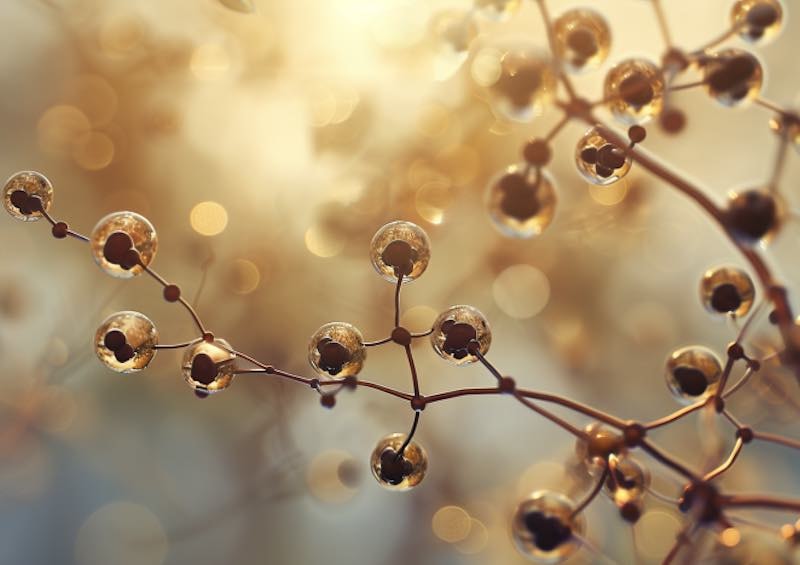
Endocrine Disruptors List: "Dirty Dozen" Endocrine Disrupting Chemicals
In Europe, there is currently a list of over 80 chemicals that have been identified as endocrine disrupting chemicals, however, as mentioned before, this number is susceptibly greater than this.
Let’s take a closer look at some of the most common hormone-disrupting chemicals that you may encounter without realizing it:
-
Per- and Polyfluoroalkyl Substances - The forever chemicals
Per- and polyfluoroalkyl substances (PFAS) are notoriously known 'forever chemicals' because they don't break down easily, either in the environment or our bodies. PFAS are well known endocrine disruptor, and are found everywhere - from non-stick cookware and water-resistant gear to personal items, stain-resistant fabrics, and even sources of drinking water. A study published by Grandjean et al. (2012) connected PFAS exposure with decreased immune function.
-
Phthalates - The flexibility boosters
Certain phthalates are added to products to give material's their flexibility, found in personal care products like shampoos, food packaging, vinyl flooring and plastic shower curtains, and even in children's toys, they pose significant health issues, often overlooked in our daily lives. Studies have linked phthalates with reduced sperm count and developmental issues (Swan et al., 2005).
-
Parabens - The 'sneaky' preservatives
Parabens are preservatives that extend the shelf life of cosmetic products like skincare and makeup but they are also hormone disruptors. They can be identified in products by the names of methyl-, ethyl- or butyl-paraben etc.
-
Bispehnol A (BPA) - The plastic offender
Found in various plastics and epoxy resins, BPAs strengthen water bottles and containers. Items marked with recycling code #7 are particularly likely to contain BPA, making it important to stay vigilant about what we store in our food in. Research has shown BPA's ability to mimic estrogen can lead to reproductive disorders including infertility (Vandenberg et al., 2012).
-
Polychlorinated Biphenyls (PCBs) - Banned but Persistent
Once widely used in electrical equipment and paints, PCBS are now banned for their toxic effects. Despite this ban, they are still lingering in our environment, and tend to accumulate in animal products particularly fish, meat and dairy
-
Dioxins - Combustion byproducts
Dioxins are highly toxic byproducts of industrial and manufacturing processes. They often accumulate in animal products, and contaminate soil and water around industrial sites, posing a risk to our health through the food chain
-
Atrazine - Weed Killer
A prevalent herbicide used in agriculture, atrazine is often used on crops and leach into nearby soil and water supplies. Overtime this contamination spreads, making its way into our food and water
-
Flame Retardants - Fire safety with a hidden risk
Brominated flame retardants are added to reduce flammability in consumer products - from furniture and electronics to insulation and children's products like car seats, and foam play matts. flame retardant chemicals come with hidden health risks, they can accumulate in dust and can be easily absorbed into the body when exposed
-
Triclosan- The 'antibacterial' additive
Triclosan, found in anti-bacterial products, was once a staple in anti-bacterial soaps, but now is being phased out due to growing health concerns, especially as an endocrine disruptor. However, it still lurks in 'anti-microbial' kitchenware, hand sanitisers, and even toothpaste
-
Perchlorate - The water contaminant
Perchlorate, an ingredient in rocket fuel and fireworks, often contaminates water sources, particularly near industrial sites. These chemicals distribute into soils, affecting crops, and creeping into meat and dairy products.
-
Arsenic – The Environmental Toxin
Arsenic is a naturally occurring element that can contaminate drinking water through industrial pollution or agricultural runoff. Long-term exposure to arsenic has been linked to various cancers as well as disruptions in hormone signaling related to insulin regulation. -
Lead – The Neurotoxic Metal
Lead is a heavy metal that can interfere with multiple bodily systems but is particularly harmful to the nervous system. It also acts as an endocrine disruptor by interfering with hormone signaling pathways. Lead exposure primarily comes from old paint, contaminated water pipes, and different products like imported toys, even in coventional cosmetics, and has been associated with cognitive deficits due to its neurotoxic effects (Lanphear et al., 2005).
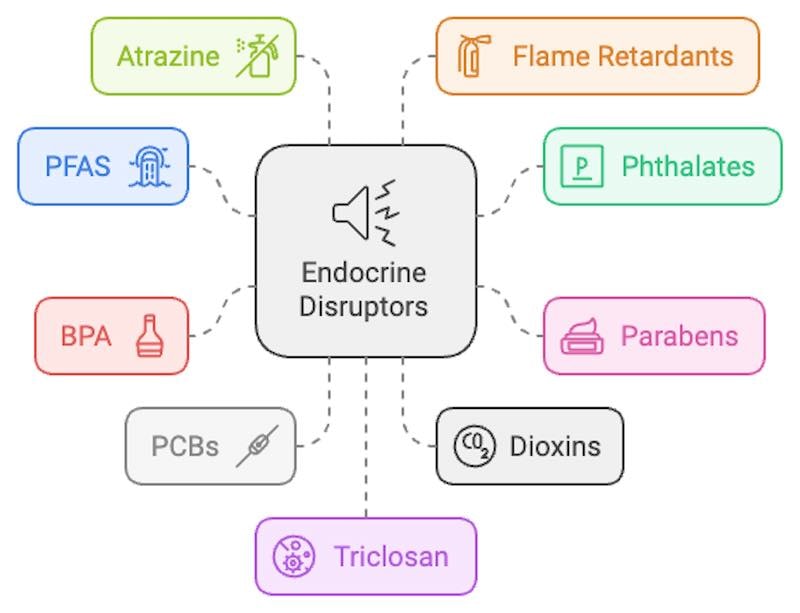
Alarmingly: Decreasing Intelligence and Fertility Rates
Researchers have observed a troubling trend: both average intelligence levels and fertility rates have been declining since around the year 2000. Studies conducted in countries like the UK and Denmark show a decrease in IQ scores after decades of continuous increase—a phenomenon attributed partly to environmental factors like endocrine disruptors (Flynn et al., 2013).
Additionally, fertility rates have dropped significantly worldwide; more couples struggle with infertility than ever before. The World Health Organization (WHO) has pointed out that endocrine-disrupting chemicals may be contributing factors by interfering with sex hormones (WHO Report on EDCs, 2012). These same chemicals are also believed to be responsible for earlier onset puberty in children as well as rising rates of breast cancer and testicular cancer (Skakkebaek et al., 2016).
Practical Trips to Avoid Endocrine Disruptors in Daily Life
1. Choose Safer Household Products
-
Non-toxic cleaning products - I started swamping out household cleaners and was pleasantly surprised by how well natural, and more non-toxic alternative cleaners do without all of the added synthetic chemicals. When shopping look for 'green-certified' products and avoid products with synthetic fragrance. Opt for more natural soaps to and avoid 'anti-bacterial' soaps as they are likely to include triclosan
-
Avoid non-stick cookware - ditch non-stick pans that release PFAS chemicals when heated, and instead purchase stainless steel, cast iron, or ceramic cookware, these alternatives are often more durable too
-
Hypoallergenic laundry products - Switch to laundry detergents and fabric softeners that are green-certified and hypoallergenic, this can be an easy swap and reduce your exposure to toxic chemicals found in conventional cleaners
2. Regularly Clean Your Home and Improve Air Quality
-
Dusting and vacuuming - Instead of dry dusting try using a damp cloth or a microfibre cloth, which helps you gather and trap household dust more effectively. A vacuum with a HEPA (high-efficency particulate air) filter can help you trap the smallest of particles more efficiently, that may be missed with a standard vacuum
-
Improve ventilation - Fresh air helps remove VOCs and makes a world of difference - keeping windows open or adding an air purifier and maybe even a few house plants can transform your space.
-
Opt for no-shoes policy - This is a simple general rule that you can implement to avoid bringing in outdoor contaminants into your living space
3. Opt for Clean Cosmetics and Personal Care Products
-
Clean Beauty - Switching my personal care products was eye opening - there are so many products that contain phthalates, parabens and release PFAS. However, I was surprised by how many great brands that offer natural alternatives. Mineral-based suncreens have also become my go-to over chemical ones, as they contain less toxic compounds, I would recommend making the swap!
-
Avoid perfumed beauty and wellness products - avoid products with 'fragrance' or 'perfume' this can be challenge but there are plenty of natural beauty ranges nowadays!
-
Limit use of chemical-based nail polishers and removers - choose brands that are labeled as '3-free' or '5-free', which indicates the absence of certain PFAS that are present in these products
4. Select Natural Materials and Fabrics
-
Choose sustainable natural fibres - Synthetic fabrics like polyester, acrylic and nylon are often treated with chemicals like flame retardants. Natural fibres like cotton, wool, linen are free of these chemicals and will feel nicer on your skin!
-
Ditch treated fabrics - Avoid fabrics with 'stain-resistant' or 'wrinkle-free' treatments as these may contain PFCs and ALWAYS wash new clothing, towels and bedding before use to reduce chemical exposure
5. Reduce plastic use
-
Avoid plastic containers and cooking utensils - Plastic containers can leach chemicals like BPA, especially when heated, so always avoid microwaving plastic products. My favourite alternative is a glass food container - it is easy to clean (and doesn't taste like plastic). Silicone and stainless steel containers are also great options. If you must use plastics, opt for BPA-free options for food storage
-
Avoid single-use water bottles - BPA is extremely prevalent in single-use water bottles, swapping to a reusable water bottle is a game changer, and you'll never have to buy another single use water bottle ever again - it is also more eco-friendly too!
-
Opt for non-plastic children's toys - Children are particularly susceptible to the harmful effects of toxic chemicals, especially as they're still growing - avoid purchasing plastic toys to prevent your children being exposed to endocrine disrupting chemicals
6. Filter Your Drinking Water and Favour Organic Food
-
Invest in a water filter - By installing a water filter you can remove pesticides, pharmaceuticals and common contaminants like BPA and PFAS, it is worth it for your health!
-
Choose organic when possible - Purchase organic fruits and vegetables to mimizine pesticide exposure, particularly items that have high pesticide residues like strawberries, apples and spinach
-
Avoid processed foods and reduce meat - Cutting back on processed foods and meats can reduce your exposure to common endocrine disruptors, also avoid canned foods (unless BPA free)
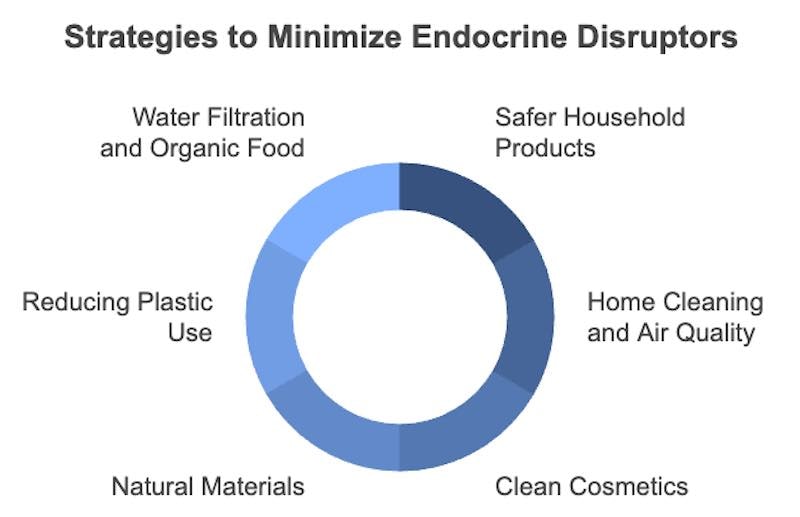
Identifying Safe Products: Certifications
When shopping for safer products that limit exposure to endocrine disruptors, look for these trusted certifications:
-
Green Seal or ECO logo - Found on cleaning products - these labels ensure products meet strict adherence to environmental health and safety standards, minimising health risks
-
USDA Organic: This label ensures that foods meet strict guidelines regarding pesticide use—important for reducing exposure from organophosphate pesticides.
-
EcoCert - Certifying personal care and cleaning products, this label confirms at least 95% natural and sustainably sourced ingredients
-
Fair Trade Certified: Ensures ethical sourcing practices while also limiting harmful chemicals used during production.
-
Greenguard certification - Used for building materials an furniture, this certification can ensure low chemical emission for improved air quality and safer products
-
EWG verified - The Environmental Working Group prioritises high health and safety standard for cosmetics and household products. Their EWG Skin Deep app is a handy tool for checking product safety, especially for cosmetics. However, there is a wealth of ingredient decoding apps that can help you read a cosmetics list.
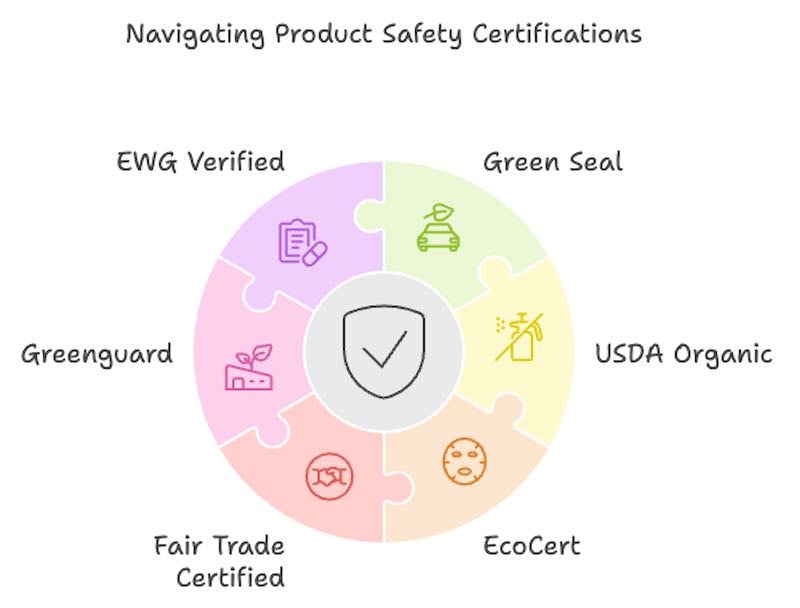
Mark Hyman’s Thyroid Support Protocols
Supporting your thyroid naturally involves not just avoiding harmful chemicals but also nourishing your body with the right nutrients and practices. Here’s a quick guide based on Dr. Hyman’s recommendations:
Key Nutrients for Thyroid Health
• Vitamin B2, B6, B12: Aid in energy production and hormone regulation.
• Vitamin D (2000 IU daily): Boosts immune function and reduces inflammation.
• Vitamin A: Critical for converting T4 to T3.
• Selenium: Essential for thyroid hormone synthesis and protection against oxidative stress (e.g., 1–2 Brazil nuts per day).
• Zinc (30 mg daily): Supports T4 to T3 conversion.
• Iron: Supports oxygen transport and thyroid function.
Adaptogens for Stress and Thyroid Function
• Ashwagandha (1000 mg daily): Balances hormones and reduces stress.
• Rhodiola Rosea: Boosts energy and adrenal health.
• Cordyceps Mushrooms: Enhances thyroid and immune function.
Lifestyle Practices
• Infrared Sauna: Detoxifies the body from endocrine disruptors like heavy metals and BPA.
• Acupuncture: Balances hormones and reduces stress.
• Daily Movement: Incorporate walking, yoga, or strength training to regulate metabolism and reduce cortisol.
• Herbal Teas: Cinnamon, ginger, and turmeric teas reduce inflammation and support digestive health.
Key Takeaways
-
While endocrine disruptors are everywhere - from our beauty products to our cookware - transitioning to a non-toxic way of living can significantly reduce our exposure through mindful choices
-
Those most vulnerable to these chemicals are pregnant women, developing babies, young children, and teenagers - making it especially important to create a safer environment for your family
-
Start with the easiest changes that have the biggest impact: switching to clean personal care products, choosing safer cookware, and filtering your drinking water
-
Remember this journey to non-toxic living is a process - focus on progress over perfection and make gradual changes that feel sustainable for your lifestyle
-
Use trusted certifications to help guide your choices when shopping for safer alternatives
If you enjoyed this post, check out these articles on safe and non-toxic products:
FAQ to Reducing Endocrine Disruptors
Is it possible to avoid endocrine disruptors?
While it is nearly impossible to completely avoid endocrine disruptors due to their widespread presence in everyday products and the environment, you can significantly reduce exposure by making informed choices. Opt for organic foods, avoid plastic containers (especially for food storage), and choose personal care products free from harmful chemicals like parabens and phthalates.
What foods are high in endocrine disruptors?
Foods that are often high in endocrine disruptors include those packaged in plastic or canned containers, as these can leach chemicals like Bisphenol A (BPA) into the food. Additionally, non-organic produce may contain pesticide residues that act as endocrine disruptors, such as atrazine. Processed meats and dairy products can also contain hormone-disrupting chemicals due to the use of growth hormones and contaminated feed.
How to reduce exposure to hormone disruptors?
Reducing exposure to hormone disruptors involves several lifestyle changes. Choose organic fruits and vegetables to avoid pesticide residues, and store food in glass or stainless steel containers instead of plastic. Opt for personal care products labeled "paraben-free" and "phthalate-free," and avoid processed or canned foods when possible. Additionally, using natural cleaning products can help minimize contact with harmful chemicals in household environments.
What products have high endocrine disruptors?
Products that commonly contain high levels of endocrine disruptors include plastics with BPA or phthalates, such as water bottles and food storage containers. Personal care items like shampoos, lotions, and cosmetics often contain parabens and phthalates unless labeled otherwise. Household cleaning products with synthetic fragrances or harsh chemicals may also contribute to exposure. Choosing safer alternatives in these categories can help reduce your risk.
What are the dirty dozen endocrine disruptors?
The "Dirty Dozen" endocrine disruptors include some of the most harmful chemicals known for their ability to interfere with hormone systems. These include Bisphenol A (BPA), dioxins, atrazine, phthalates, perchlorate, fire retardants (PBDEs), lead, arsenic, mercury, perfluorinated chemicals (PFCs), organophosphate pesticides, and glycol ethers.
What is the most common endocrine disruptor?
One of the most common endocrine disruptors is Bisphenol A (BPA), which is widely used in plastics and epoxy resins found in food containers, water bottles, and can linings. BPA is known for mimicking estrogen in the body and has been linked to various health issues, including reproductive disorders and metabolic problems













